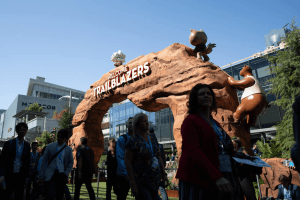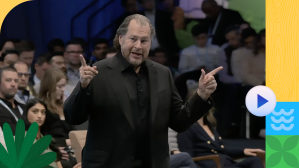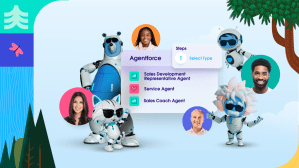Dreamforce has come a long way since its first edition 16 years ago. Back then, a few more than 1,000 people gathered at a single San Francisco hotel for 50 or so sessions on how a startup company with a cloud-based CRM application could help companies grow their sales.
Today, Dreamforce has 171,000 registered attendees signed up for a four-day celebration of the Salesforce Trailblazer community, all focused on how business – and every attendee – can be a change agent in the world. Leaders in business, politics, entertainment, sports, and more are featured speakers, and technology of course takes a front seat. And the event keeps getting bigger.
“Every year we say, ‘This year is going to be the biggest and best Dreamforce ever,’” says Salesforce Vice President and Dreamforce Event Chair Brigitte Donner, “and somehow, we actually make that happen and raise the bar.” [click-to-tweet]
Here’s how Dreamforce gets made.
Planning the world’s largest software conference
The four days of Dreamforce bring a huge influx of people to the City by the Bay, filling up every hotel room and Airbnb in the area. Planning an engaging experience for that many people is a big deal. A small, core team of full-time staffers are dedicated to planning the event, says Donner. But really the entire company has a role in producing Dreamforce.
“I tell people my team is 45,000 strong, because the reality is the entire company gets behind Dreamforce and wants it to be amazing for our customers, our partners, and our entire ecosystem,” Donner says.
It all starts with a V2MOM — that is, Salesforce’s goal-setting framework that defines vision, values, methods, obstacles, and measures. This version of the document is Dreamforce-specific and becomes a source of truth for how the entire extravaganza is produced and what the ultimate messaging of it is. This year, that team is building the event around three major themes: the Trailblazer community, the idea of business as a platform for change, and a focus on Customer 360 – Salesforce’s platform that allows companies to build amazing experiences for customers. These themes will manifest through physical locations, product demos, and themed keynotes and panels.
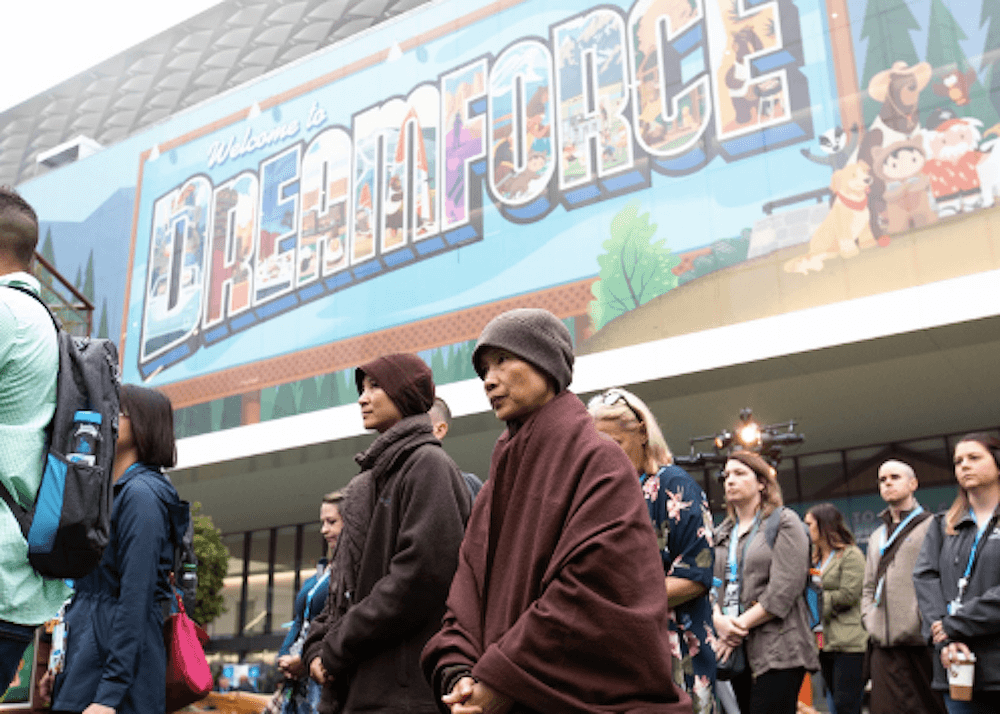
“For instance, we’ll use our own Salesforce products to organize and run the entire event,” says Donner, “like Marketing Cloud for personalized agendas for attendees, Service Cloud for onsite technical support, Einstein for reporting and dashboards on partner information, and the Salesforce Events App built natively on our platform.”
“Business as a platform for change” is leveling up this year. Salesforce has integrated this idea as a recurring theme in recent years, but it has a new face in 2019. Last year’s Dreamforce saw the debut of the Climate Summit, which included speakers like former U.S. Vice President Al Gore discussing environmental solutions. That event-within-an-event returns this year, but also sees the debut of the Sustainability Summit, with programming based on the United Nations Sustainable Development Goals that will draw some 25 CEOs.
This isn’t just us talking about business being a platform for change.
“It’s really important to us that it isn’t just us talking about business being a platform for change,” says Salesforce Chief Marketing Officer Stephanie Buscemi. “The CEOs at the Sustainability Summit are showing their commitment and how their companies align with these UN goals and what action they’re taking.”
The making of Dreamforce’s opening keynote
Among the most anticipated moments at every Dreamforce is the opening keynote. And since the very first edition in 2003, Salesforce’s co-CEO, Chairman, and founder Marc Benioff has hosted the tone-setting presentation, which lays out the themes and presents customer success stories and product announcements. Between the attendees live in the room and the millions watching via live stream, it’s a big moment for Salesforce. Not surprisingly, a lot goes into its planning.

The themes come to life 2-3 months before Dreamforce. That might seem like a quick turnaround, but the seeds are planted months earlier. Salesforce Senior Vice President of Corporate Messaging & Content Al Falcione leads a small team that hits the road to meet with more than 100 customers and thought leaders in focus group-style formats to find out what challenges and opportunities are top of mind for them. They then figure out how that feedback maps back to the corporate themes Salesforce has committed to for its fiscal year, like the power of Einstein AI or Customer 360.
Falcione and team then curate that feedback into a smaller handful of possibilities for how to bring those themes to life on stage, usually through the prism of customer stories and current economic and social trends, as well as those actual Salesforce product launches. Benioff provides feedback early and often, and his “hands-on, passionate approach,” as Falcione says, is intrinsic to creating a keynote that authentically connects with the audience.
Thousands of people get a chance to offer feedback – including Colin Powell. Benioff tests the messaging of his keynote dozens of times, often with those same customers who guide the thinking on themes. In all, some 160 customers get a chance to see the presentation from start to finish, including the product demos and short films that give the keynote its color. All get an opportunity to deliver constructive feedback, which regularly makes its way into the planning before the keynote is finalized.
This guy is a four-star general, and he’s giving me awesome feedback.
“We learned from past experiences that if you don’t get that feedback from customers early in the game, the messaging won’t resonate,” says Falcione. “That’s why we do these road shows – so the process is more inclusive and more iterative.”
Key feedback once even came from retired general and former U.S. Secretary of State (and now a Salesforce Director) Powell, who heard an early version of the 2012 keynote and told Falcione he needed to uncomplicate the messaging.
“This guy is a four-star general, and he’s giving me awesome feedback,” laughs Falcione. “He basically said, ‘Simplify the message on each slide. Don’t give them too much.’” [click-to-tweet]
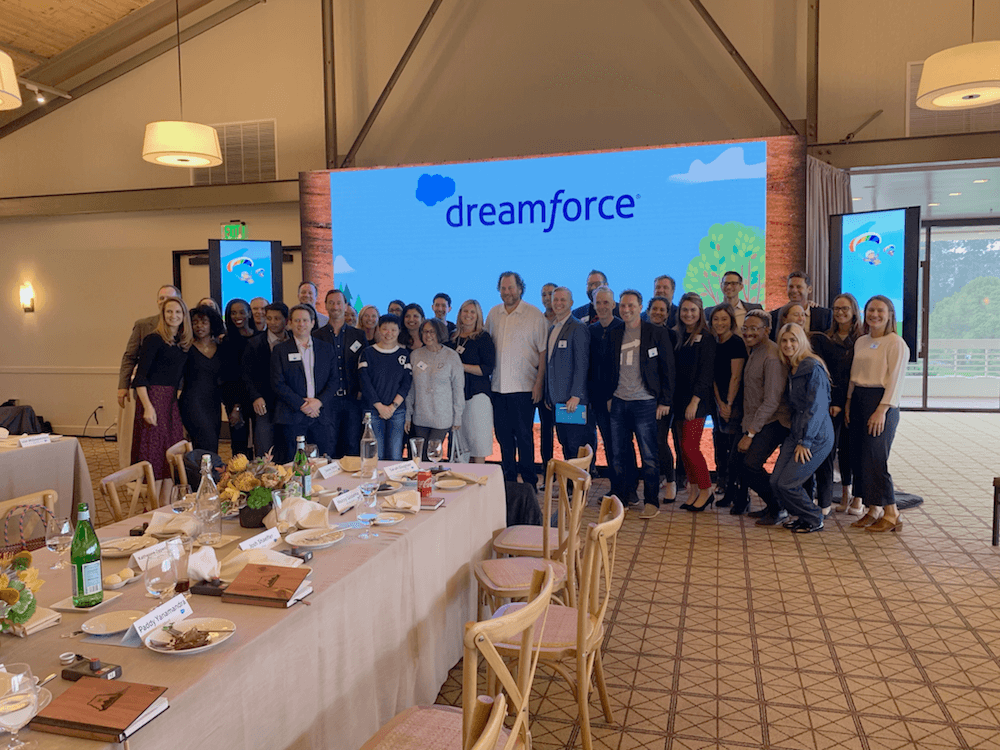
In the days preceding Dreamforce, Benioff reviews and runs through the keynote literally every day – sometimes multiple times a day. Then 24-48 hours before he delivers it to the public, every Salesforce employee gets an opportunity to hear it live and offer their own feedback.
“They’re our biggest critics because they know the products,” says Falcione. “They know who we really are as a company, and it’s that final set of feedback from employees that keeps us true to our DNA. At that point, we’re ready to go.”
This year’s keynote will be like a rock concert – literally. Metallica show designer and director Dan Braun has been helping produce the keynote for years, a product of Salesforce’s long relationship with the iconic Bay Area band. He partners with an internal team that works on all Salesforce keynotes, globally and year-round, as well as a London-based production agency.
According to Falcione, this edition of the keynote address will be “theatrical,” and one of the more impressive ones in terms of production value. Huge LED screens will amplify the core messages and project speaker images to the 8,000-seat Hall D at Moscone Center, in addition to the millions watching via live stream.
“Dan helps us with the in-room experience and how we can create emotion in a large room,” says Falcione. “He’s a pro at creating these huge moments, like he’s done for Metallica for years. He’s a great influence on us, our company, and our keynotes.”
Booking the speakers (and the band)
Signing big names from the corporate world and the celebrity universe grabs a lot of attention at Dreamforce, and this year is no different – from former U.S. President Barack Obama to film director Richard Curtis and World Cup winner Megan Rapinoe, there’s no shortage of star power among the keynotes and panels. Not surprisingly, getting commitments from such luminaries – and managing them on site – is a challenging task.
A small team of Salesforce employees book more than 300 speakers. And the members of that team are often amazed what they pull off: “You should see the permanent eye twitch I have right now,” laughs Senior Vice President of Strategic Events Karin Flores, who leads the team of planners.
Booking speakers is a collaborative process that involves a number of stakeholders at Salesforce. Product marketers will put forward customers who align well with Salesforce product announcements, the Sustainability team will nominate VIPs in the nonprofit and environmental worlds, the Executive team will suggest thought leaders, and so on. Flores’ team tries to find a balance between the types of people invited and keeps a major eye on having a diverse set of speakers that is representative of the communities Salesforce serves.
“That process often takes a year or more for people we’ve been pursuing,” says Flores, “but many only get finalized four months or so before the event.”
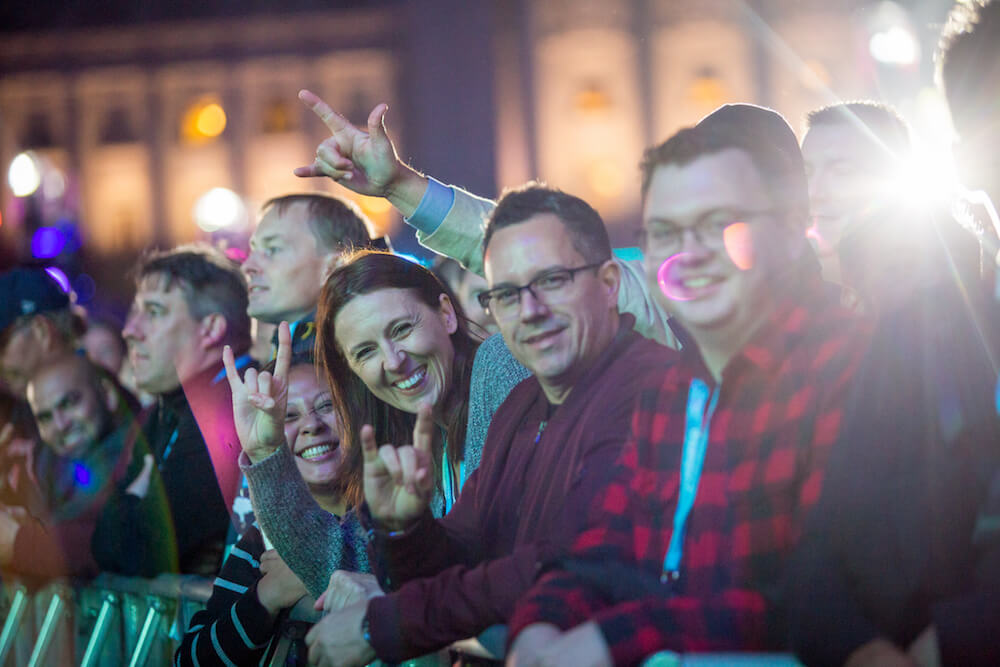
The work is often harder during Dreamforce, when Flores and her small team double as personal handlers for every single invited speaker. That involves meeting every guest (and their support staff) and guiding them through the experience.
Bands can take literally years to book. Flores and team maintain a running wish list of 20-30 bands they’d like to see perform at the annual Dreamfest benefit concert, which raises millions of dollars for the UCSF Benioff Children’s Hospitals in San Francisco and Oakland. Past performers include (to name a few) U2, Foo Fighters, Lenny Kravitz, Alicia Keys, Red Hot Chili Peppers, Bruno Mars, the Black Crowes, will.i.am, and Stevie Wonder. Sometimes the booking is made easier when a big-name band also happens to be a Salesforce customer, like Metallica. But often it’s about being in the right place at the right time.
This year’s headline performer is Fleetwood Mac – and the Rock & Roll Hall of Famers have been on that wish list for several years, according to Flores. It just so happened the timing was finally right.
“Sometimes bands we want are in the studio, so they’re unavailable,” says Flores. “Other times they’re on hiatus, and it’s a nonstarter. The sweet spot is if they’re out on tour, because they’re rehearsed and performing. But then it’s about figuring out if their tour schedule lines up with a trip to California. With Fleetwood Mac, it worked out perfectly.”
The look and feel of Dreamforce
Designing the physical experience of Dreamforce is no small task. Senior Vice President of Brand, Content, and Customer Insights Colin Fleming and his team of designers, writers, and messaging experts are responsible for bringing the entire campus to life – not just with consistent Salesforce branding, but a creative streak that makes the whole event unique and memorable from one year to the next.
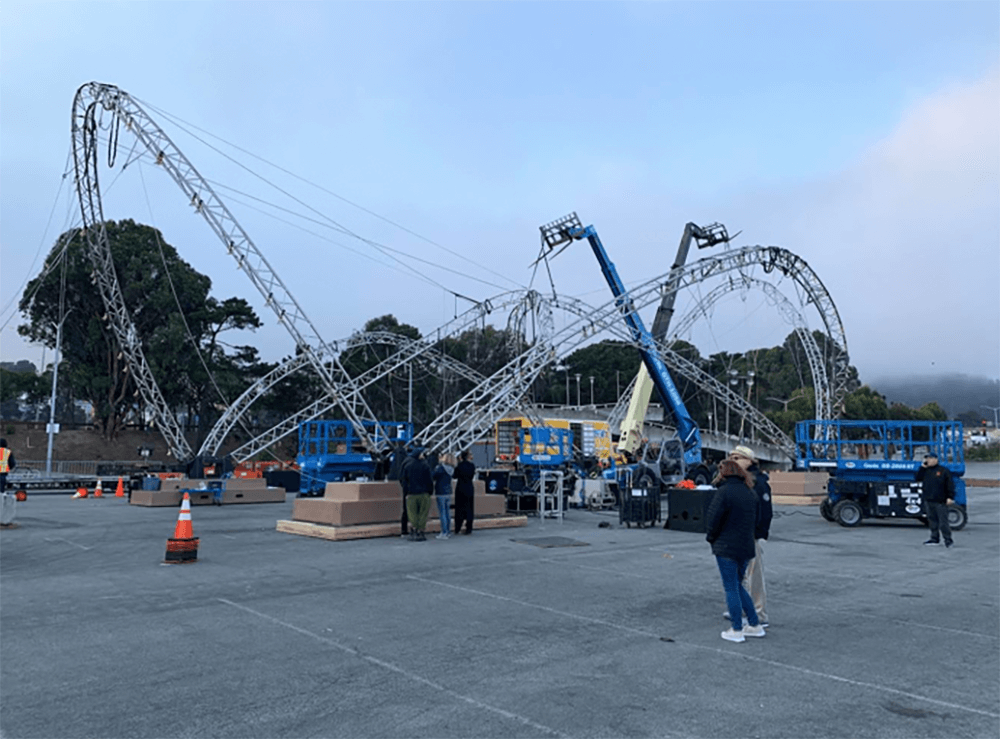
Inspiration comes from everywhere – even the movies. Dreamforce National Park has been a successful design concept since 2017, and the rustic theme will return for this year’s event. The rationale is that the outdoors and “blazing trails” ties right in with the entrepreneurial spirit of the Trailblazer community. That element of this year’s inspiration comes from Olympic National Park in northwest Washington state – the Dreamforce grounds will be liberally decorated with nods to the Pacific Northwest rain forests and glaciated mountains, and thousands of live plants brought in specifically for the event.
That will pair nicely with another theme: the “Autumn of Customer Love.” In a nod to San Francisco’s bohemian culture of the late ’60s and early ’70s, depictions of Astro, Codey, Einstein, and Salesforce’s other familiar Trailhead characters will be clad in hippie-friendly attire. Visitors will even get to see them riding in an era-appropriate Volkswagen bus.
Another theme comes from another planet. Fleming reports the Creative team was also heavily influenced by the 2009 sci-fi film Avatar, which is set on the fantastical world of Pandora. Neon blues, purples and greens will be everywhere at Dreamforce. That extends to what Fleming and team refer to as “BSROs” (big, shiny, relevant objects) present in every major zone of the campus.
You’ll see Pandora’s influence in a lot of places including a 20-foot-tall ‘Tree of Life
“You’ll see Pandora’s influence in a lot of places,” he says, “including a 20-foot-tall ‘Tree of Life’ made up of giant LED screens that tell stories about Salesforce customers, a ‘data waterfall’ that shows off Einstein analytics, and the lighted ‘Dreamforest Canopy’ that will cover Howard Street, which is closed between 3rd and 4th Streets for the event.” [click-to-tweet]
It’s all about creating an atmosphere, but also about making Dreamforce unique.
“While Dreamforce is ultimately the manifestation of Salesforce’s brand, we try not to take ourselves too seriously at this event,” Fleming says. “It’s very much a focus on being different and unique, but also un-intimidating, more like a family reunion.”
Dreamforce exists in VR before it becomes “IRL.” Detail is everything, which is why Fleming and his team actually design all 240,000 square feet of event space in a virtual environment (and with more than 10,000 individual graphic files) before it’s built out. The benefit is that they can make tweaks and experience them in as close to a real environment as possible before the event is actually physically constructed. End result, it’s possible to take a virtual tour of all of Dreamforce with a VR headset on.
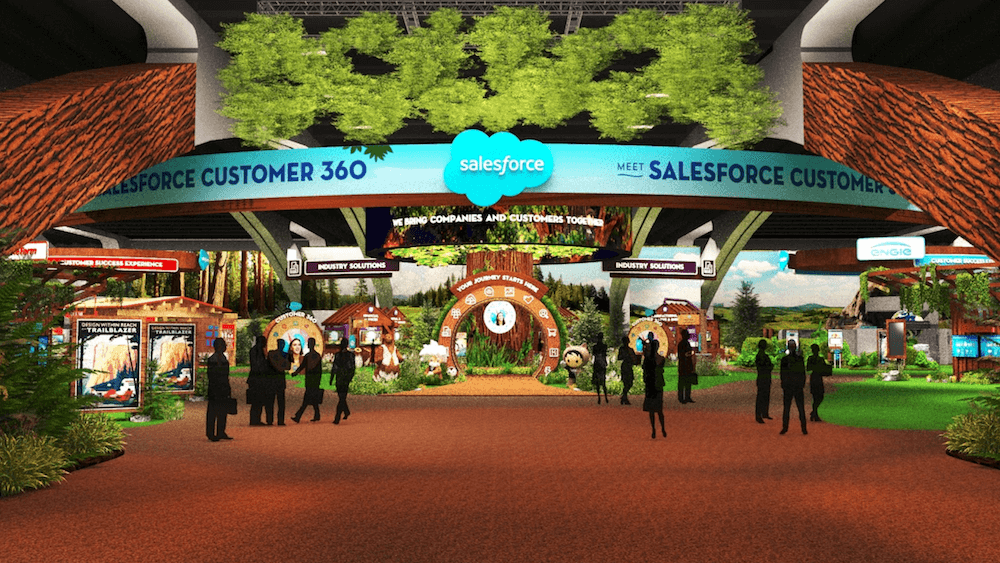
“I know the height of every sign, the color of every corner of the campus,” says Fleming. “I already know what it’s going to look like. Our attention to detail is almost scary.”
Indeed, all those details require a village — of Salesforce employees, customers and partners, inspirational people from all walks of life, and more — to make Dreamforce a memorable experience. At the end of the day, says Buscemi, it’s about creating an experience that is unlike any other trade show.
..it becomes the ultimate celebration of our customers
“When you get this many people and that much energy together, it becomes the ultimate celebration of our customers,” says Buscemi. “And it’s a rare opportunity to get them all together at once. The kind of connections people make, the kind of learning opportunities they have access to, the inspirational moments that are out there – it’s a level of connectedness that’s like no other.”
Get ready for the big kickoff on Tuesday, Nov. 19. Make sure to check back at salesforce.com/news for the latest information about Dreamforce 2019, and check out our guided agenda to the event.
